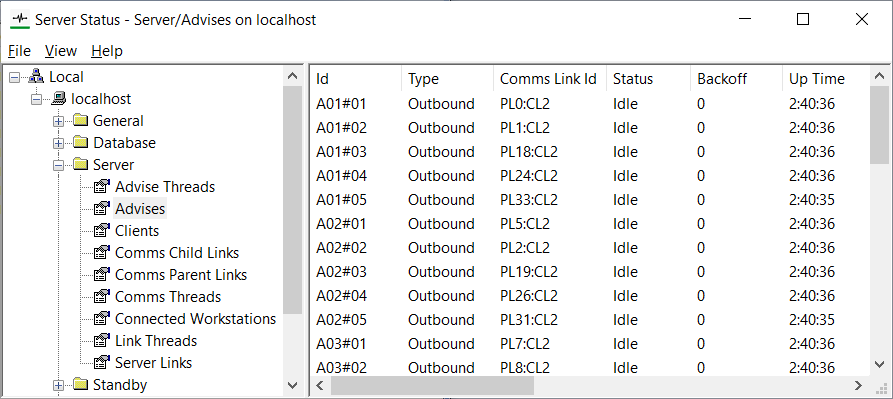The Advises category provides status information about the advise links between the server and clients. The server advise links enable the server to send unsolicited messages to the clients.

The status information for each server advise connection is categorized under these headings:
- Id—The identification number that has been allocated to the server to client connection by Geo SCADA Expert.
- Type—Indicates whether the advise connection is an Outbound connection (server to client) or an Inbound connection (client to server).
- Comms Link Id—Indicates the comms link that is servicing the advise. The format is
PLx:CLywherexis the number of the parent link andyis the number of the child link. The Ids match those shown in the Id columns in the Comms Parent Links and Comms Child Links categories of the Server Status Tool. - Status—Indicates the present condition of the server advise connection. This can be:
- Idle—The server advise is connected and is available for use (but is not currently being used)
- Advise Pending—The server advise has an active Event queue and is in the process of being established. This status should only be displayed momentarily when the server advise connection is first established.
- Connecting—The server advise is in the process of trying to connect to the client. If the server advise remains in this state, it means that the server advise is continuously trying to connect but is unsuccessful. This can be due to a network failure or a firewall being incorrectly configured (see the Geo SCADA Expert Guide to Client Administration for more information).
- Sending Events—The server advise is currently being used to send an unsolicited message to a client.
- Closing—The server advise is in the process of closing down. This occurs as part of the shut down procedure when the client disconnects from the system.
- Closed—The server advise is closed. This can be due to the socket being closed, and is usually a temporary status as the server advise connection should be retried automatically.
- Backoff—The amount of time that the server is waiting during the current backoff period. Under normal working conditions, the Backoff is 0.
On systems where the server connects to a client via a network, there is a greater possibility of the server being unable to connect to the required client due to abnormal conditions on the network. The Backoff feature stops the server from making excessive re-connection attempts that could cause further problems on the network.
If a server is unable to connect to a client due to abnormal network conditions, it will wait for a set amount of time before it attempts to reconnect. If the re-connection attempt is unsuccessful, the server will wait for a longer amount of time before making another re-connection attempt. This amount of time is called the Backoff period and it is double the amount of time of the previous connection delay. For example, if a connection attempt was made after a delay of 2 minutes and the connection was unsuccessful, there would be a backup delay of 4 minutes before the next re-connection attempt.
The maximum Backoff time is 8 minutes. If the re-connection cannot be made after 8 minutes, the server will continue to make re-connection attempts every 8 minutes.
- Up Time—The amount of time for which the link has been connected, in the form hh:mm:ss (where h is hour, m is minute, and s is second).
- Idle Time—The amount of time for which the link has been connected but not in use.
- Idle Polls—A count of the idle polls that the server has sent to the client to ensure that the connection is still valid. The idle polls occur if no events have been generated for a period of time.
- Links—The number of connections that are made via the server advise.
- Evt Pend—The number of unsolicited updates waiting to be sent from the server to the client.
- Evt Max—The maximum permitted number of unsolicited updates that can be sent from the server to the client.
- Evt Sent—The total number of unsolicited updates that have been sent from the server to the client. This indicates the previous load on the connection.
- Data Sent—The total amount of compressed data sent to the client. This is the actual amount of data transmitted across the network.
- Content Sent—The total size of the data sent to the client before compressing.
- % Compressed—The amount by which the data transmitted from the server to the client could be compressed. For example, 90% compression means that the actual transmitted data was compressed to 1/10 of its original size.
You should pay particular attention to the Status and Evt entries. If your system is working correctly, the Status is — and the Evt is 0.
You should also pay attention to the Backoff entry. If this shows anything other than 0, there may be abnormal network conditions that mean the server is unable to connect to the client successfully.
For more information, see Server to Client Link Problems.